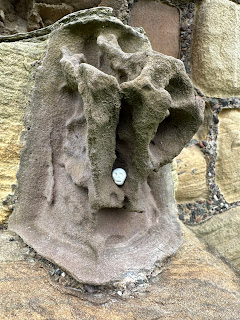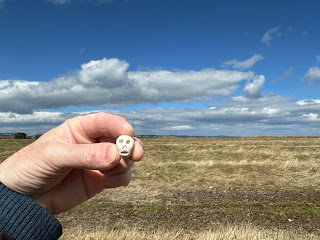A
few years ago, I was on holiday in the Netherlands and came back home on the
Amsterdam to Newcastle Ferry. In the
morning, as we approached our home port, we passed the rather impressive ruins
of Tynemouth Priory sitting high on the cliffs overlooking the sea. At the time I said to myself that I’d have to
come down and have a wander around them, and several years later I did just
that.
So,
on a rain soaked and foggy morning I left Newcastle and took the Metro down to
Tynemouth. A quick walk from the station and through the town took me to the craggy
headland on which the ruins of the priory sit.
There, I roamed around the medieval gatehouse building, the historic
ruins of the priory, through the weather worn gravestones of the graveyard and
over to the Second World war gun emplacements.
Every so often the fog and mist would roll in, then I’d be lashed by
rain, and then dried and scorched by the sun.
Basically, I had a day out in good old Northern weather, and yes, before
anyone asks, like anyone who is from Britain I am obsessed by the weather. But moving on …
The
headland on which Tynemouth Priory sits has been inhabited on and off for a couple
of thousand years. This probably being
down to the fact that it is a bit of land that was almost impregnable from attack
given that it is connected to the mainland only by a narrow strip of rock, with
steep cliffs on all other sides. So, up
until canon and big guns came along it was a relatively safe place to live, if
not the most hospitable. Remains of a
settlement pre-dating the Roman occupation, probably from the Iron Age, have
been discovered there, along with another from around the 2nd
Century. The land, however, does not
appear in the written record until the 8th Century, when a monastic
community was established there. Their
original wooden buildings were destroyed during the 9th and 10th
Centuries, in the Viking invasions, which shows that even the safest places
weren’t that safe back in the good old days.
The
stone ruins of Tynemouth Priory that stand there today date from the late 11th
Century and on being built were dedicated to St Oswine, with his remains kept in
a shrine within the building.
Who
was St Oswine you may wonder, I certainly did.
Well, in 644, on the death of King Oswald of Northumbria, the land was
basically split into two with Oswine succeeding as King to an area called
Deira, while a bloke called Oswiu became King of the other bit, Bernicia. For a few years all was fine, but then Oswiu
decided he wanted to rule over the whole of Northumbria so declared war on
Oswine. Oswine, being a good man who did
not want any bloodshed, refused to do battle with Oswiu. He then sought refuge with his trusted friend
Humwald. Unfortunately for Oswine,
Humwald was a bit of a shit friend and betrayed him to Oswiu, who promptly had
him murdered. After having Oswine killed, Oswiu was obliged by Ango Saxon
tradition, being one of Oswine’s nearest relatives, to seek some sort of
justice for his death. This made things
all a bit awkward, what with Oswiu being the one guilty of the murder, so, in
order to even things out he splashed some cash and founded an abbey at Gilling
in North Yorkshire. There monks offered
up prayers for Oswin’s soul and a cult gradually grew up around the slain
king. It was said that after his death
he had carried out various miracles, and at some point he became venerated as a
saint. He is now the patron saint of
those who have been betrayed, so if your girlfriend/boyfriend/non-binary other
half has ever done the dirty on you, he’s the one to pray to. Not sure what he’d do, maybe get a seagull to
poo on their head or something like that.
Tynemouth
Priory thrived up until the Reformation in the 16th Century, though
appears not to have been the most popular posting for monks with the abbots of
St Albans sending misbehaving monks there as a punishment. One monk sent there in the 14th
Century wrote a letter complaining of the relentless noise of the sea and the
seabirds, the rough sea sending many ships onto the rocks below, that the monastery
was a ‘comfortless place’ and that though food was plentiful it was mainly just
fish. He did however find that the
church there was of ‘wonderous beauty’.
Talk
of food leads me on to another story, in the grounds of Tynemouth Priory stands
a stone known as the Monks Stone. It
originally stood in the village of Monkseaton, but was moved to the priory in
1935. The tale behind this stone is that
long, long ago a monk from Tynemouth was paying a visit to the home of one of
the noble families in the area, the Delavals.
On arriving there, he found that dinner was being prepared for the
master of the house who was out hunting.
One of the dishes was a roast pig, and on seeing this the monk’s mouth
began to water. Oh, what he’d give for
some delicious pork, so much tastier than the boring fish dishes he was used to
at the monastery. The monk was offered
some food, but told that the pig had been specially prepared for Mr Delaval,
and should therefore not be touched. The
monk didn’t listen though, and when no one was around he cut off the head of
the pig, which was considered to be the tastiest part of the animal in those
days, stuck it in his bag and snuck off back towards the priory. Mr Delaval, on returning home, saw that the pig’s
head was missing and flew into a rage.
He demanded to know who had taken it and on being told about the monk,
he ran out of the house to chase after him.
He soon caught up with him, as the monk had only gone a short distance
before he’d sat down to gobble up his ill-gotten gains. Delaval then beat the monk up so badly that he
could not even walk and had to crawl his way back to the priory. There he was nursed back to health, but then
died the following year. It was said
that his beating had not been the cause of his death, but the monks at the
priory, spotting a way to get some cash out of this, charged Delaval with
murder. He was then absolved of this on
the condition that he gave them a hefty chunk of the land that he owned and
also that he erect a stone at the spot where he had ‘murdered’ the monk. The stone was erected and on it was inscribed
– ‘O Horor to Kill a man For a Piges head’.
In
1539, stooges acting for King Henry VIII forced the Prior to surrender Tynemouth
Priory and all its possessions to the king.
All the valuables were seized, and the shrine of St Oswine was broken up
with his bones being removed and scattered.
However, one small part of the priory survived pretty much intact, a
small chapel called the Percy Chantry. A
place I found gave welcome shelter every time the rain came in.
The
headland on which Tynemouth Priory stands was, up until the 1950s, seen as
having strategic importance in guarding over the mouth of the Tyne. It was quite heavily fortified with various
buildings added for its defence. Of
these all that now remain are the Gatehouse, which was built in the 14th
Century, and various gun emplacements built up from the 19th Century
through to World War II.
In
the 17th Century a lighthouse was built on the headland to guide
ships into the Tyne and away from nearby rocks.
By all accounts a spectacular building, it sat there until 1898, when
having become obsolete due to the construction of the piers at the entrance to
the Tyne, it was demolished.
At
the end of my soggy trip to Tynemouth, I left the Skulferatu that accompanied
me in one of the pockmarked and weathered stones in the priory wall.
The
coordinates for the location of the Skulferatu are -
I
used the following sources for information on Tynemouth Priory –
























































